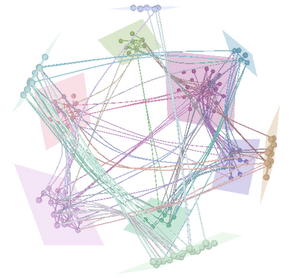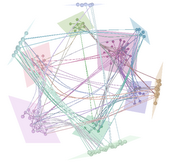Information
- Publication Type: Bachelor Thesis
- Workgroup(s)/Project(s):
- Date: April 2022
- Date (Start): 2021
- Date (End): April 2022
- Matrikelnummer: 11776883
- First Supervisor:
Abstract
Simple graphs are often not able to accurately represent real world entities. Therefore, more complex data structures have been introduced, one of which is the so-called “multilayer network”. Multilayer networks are used in multiple fields, such as medical science, where data can represent the correlation of diseases or social science, where data might represent different actors and their relationship to one another.Visualizing these complex data types is particularly challenging, as two-dimensional visualizations - the gold standard for graph visualizations - are often not good enough to gather deeper insight into the data, as big datasets quickly fill two-dimensional visualizations with visual clutter. Therefore, this thesis introduces a new visualization technique for multilayer networks by extending existing 2d state-of-the-art methods with a third dimensions.
Our solution visualizes the layers as sub graphs on a two-dimensional plane, which are positioned around a sphere. To optimize the layout within the layer for multilayer networks, our solution calculates the position of individual nodes by considering connections within the same layer, as well as connections to other layers. To minimize visual clutter, edge bundling was implemented, additionally to a view, which restricts the visualization to nodes and edges of a single layer, as well as connections to nodes of other layers. Our results show that our solution with the additional space due to the third dimension, combined with an optimized layout, allows users to visualize larger networks and gather better insight into the data, compared to conventional two-dimensional
Additional Files and Images
Weblinks
No further information available.BibTeX
@bachelorsthesis{lippeck-2022-mna,
title = "3D Graph Algorithm for Multilayer Network Analytics",
author = "Daniel Lippeck",
year = "2022",
abstract = "Simple graphs are often not able to accurately represent
real world entities. Therefore, more complex data structures
have been introduced, one of which is the so-called
“multilayer network”. Multilayer networks are used in
multiple fields, such as medical science, where data can
represent the correlation of diseases or social science,
where data might represent different actors and their
relationship to one another. Visualizing these complex data
types is particularly challenging, as two-dimensional
visualizations - the gold standard for graph visualizations
- are often not good enough to gather deeper insight into
the data, as big datasets quickly fill two-dimensional
visualizations with visual clutter. Therefore, this thesis
introduces a new visualization technique for multilayer
networks by extending existing 2d state-of-the-art methods
with a third dimensions. Our solution visualizes the layers
as sub graphs on a two-dimensional plane, which are
positioned around a sphere. To optimize the layout within
the layer for multilayer networks, our solution calculates
the position of individual nodes by considering connections
within the same layer, as well as connections to other
layers. To minimize visual clutter, edge bundling was
implemented, additionally to a view, which restricts the
visualization to nodes and edges of a single layer, as well
as connections to nodes of other layers. Our results show
that our solution with the additional space due to the third
dimension, combined with an optimized layout, allows users
to visualize larger networks and gather better insight into
the data, compared to conventional two-dimensional",
month = apr,
address = "Favoritenstrasse 9-11/E193-02, A-1040 Vienna, Austria",
school = "Research Unit of Computer Graphics, Institute of Visual
Computing and Human-Centered Technology, Faculty of
Informatics, TU Wien ",
URL = "https://www.cg.tuwien.ac.at/research/publications/2022/lippeck-2022-mna/",
}

 thesis
thesis

